Kitchen set made with the English patchwork technique
Post from EditorialsUsing the Traditional English Patchworck you can make splendid pieces for the kitchen (pot holders, trivets and centerpieces) recycling small scraps of cloth.
English patchwork
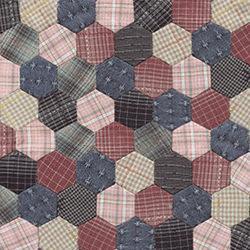 The patchwork (literally, work with patches) is a sewing technique that allows to recycle scraps of fabric otherwise unusable, putting together small pieces of fabric cut according to geometric shapes and sewn together to form precise motifs (each of which has traditionally a name and often a precise meaning), to obtain furnishings textiles such as quilts, tapestries or centerpieces.
The patchwork (literally, work with patches) is a sewing technique that allows to recycle scraps of fabric otherwise unusable, putting together small pieces of fabric cut according to geometric shapes and sewn together to form precise motifs (each of which has traditionally a name and often a precise meaning), to obtain furnishings textiles such as quilts, tapestries or centerpieces.
In particular, the so-called English patchwork or English method is the oldest and most authentic technique, because all the geometric shapes that make up a product are first cut out of paper and then hand sewn: every realization therefore requires a lot of care, time and effort.
The most used geometric form is the hexagon, with a quite charming aesthetic effect, and the decorative pattern that results brings the beautiful name of grandmother's flowers garden, which literally means the flower garden of the grandmother in this article, I will teach you how to achieve with your hands beautiful objects for the kitchen (also excellent as Christmas gifts), and more precisely a set of potholders, a trivet and a centerpiece.
How to proceed
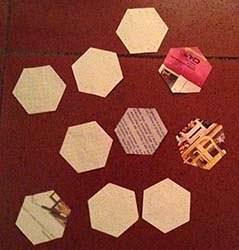 So if you want to try your hand with this technique, as I do every now and then to relax - and therefore the following recommendations are the result of my experiments - armed with scissors, paper (including recycled, provided strong enough), needle, thread and fabric course: will be perfect even small swatches remained when shortening a dress, other sewing or possibly recovered from clothing, towels and tea towels that you don't use anymore.
So if you want to try your hand with this technique, as I do every now and then to relax - and therefore the following recommendations are the result of my experiments - armed with scissors, paper (including recycled, provided strong enough), needle, thread and fabric course: will be perfect even small swatches remained when shortening a dress, other sewing or possibly recovered from clothing, towels and tea towels that you don't use anymore.
Basic module
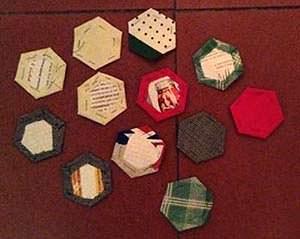 First, you need to draw on a sheet of paper a regular hexagon with the side of three centimeters: those familiar with CAD programs will not have any particular problems, while others will build it with ruler and compass (not hard: just follow for example, the simple rules of the website Viva School) or even download it from the Internet and print it. Hexes will be many, because our kitchen accessories will be formed by several of these pieces.
First, you need to draw on a sheet of paper a regular hexagon with the side of three centimeters: those familiar with CAD programs will not have any particular problems, while others will build it with ruler and compass (not hard: just follow for example, the simple rules of the website Viva School) or even download it from the Internet and print it. Hexes will be many, because our kitchen accessories will be formed by several of these pieces.
So, after having cut a sufficient number of paper hexagons, tack weld on the fabric and cut it with a pin, leaving about an inch of fabric on the edge. Next, fold the fabric on the paper, trying to be as accurate as possible, and baste normally: these are the basic shapes of our objects.
Pot holders
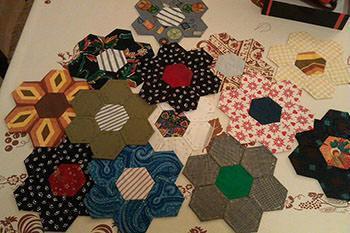 A pot holder is made of seven hexagons, one central and six external, and therefore constitutes a basic module grandmother flower to your taste, you can only use two patterns (one for the center and one for external hexagons, so as to suggest best flower motive), or pull the fabric casually; I personally prefer the first system, usually choosing a fancy to the outside and a plain fabric for the center, or vice versa.
A pot holder is made of seven hexagons, one central and six external, and therefore constitutes a basic module grandmother flower to your taste, you can only use two patterns (one for the center and one for external hexagons, so as to suggest best flower motive), or pull the fabric casually; I personally prefer the first system, usually choosing a fancy to the outside and a plain fabric for the center, or vice versa.
Subsequently, pull hexes already basted twos right sides together, and sew by hand with small stitches overcast: Proceed as follows to complete a single flower. The result should be similar to that of the photo beside, where the hexagons already sewn are ready to become potholders. When finished, iron the flowers on the reverse side to secure the folds, cut points basting and gently remove the paper hexes: the cloth should remain perfectly fit.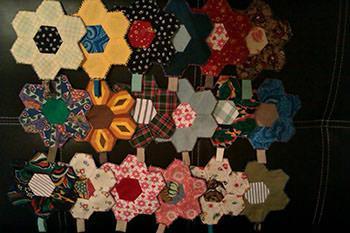 We must now think of the padding, so as not to burn yourself when you will use potholders: then take a rather thick cloth, obtained for example from old towels, tea towels, or even jeans, and fold it double, to get two or more layers (the number of layers for stuffing obviously varies according to the thickness of the fabric you used).
We must now think of the padding, so as not to burn yourself when you will use potholders: then take a rather thick cloth, obtained for example from old towels, tea towels, or even jeans, and fold it double, to get two or more layers (the number of layers for stuffing obviously varies according to the thickness of the fabric you used).
Pin the fabric on the pot holder (a pin for each external hex), and cut leaving some room for more. Next, gradually remove the fabric in excess with a pair of scissors for embroidery, as they proceed to unite the straight (pinch) with the wrong (padding) using points overcast and a drizzle of colored wool or cotton embroidery, to create a decorative sewing. During this work, do not forget to create a loop for hanging pot holders, placing in the seam a small loop of ribbon or of folded cloth, perhaps with the same decoration on the pot holder.
Trivet
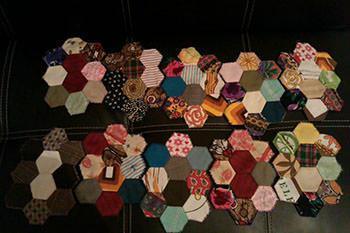 The trivet, can also be used as a mitten to extract the hot pans from the oven, they are made following the same rules and procedures that we used with the pot holders: however, in this case the hexagons are ten in total, two in the center and eight external, as you can perfectly see in the photograph on the left.
The trivet, can also be used as a mitten to extract the hot pans from the oven, they are made following the same rules and procedures that we used with the pot holders: however, in this case the hexagons are ten in total, two in the center and eight external, as you can perfectly see in the photograph on the left.
Centerpiece
Being formed by seven grandmother's flowers (one central and six external), for a total of forty-nine basic modules, a centerpiece is much more laborious to make, although the technique of execution is the same one that we have used to make the pot holders: the only difference is in fact the padding, which in this case is superfluous and can be replaced by a simple lining of lightweight fabric, to be applied in the same way as before.
79163 REGISTERED USERS










